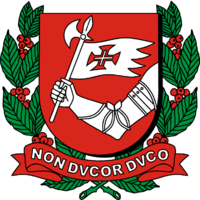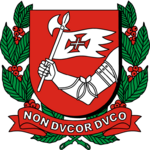Cabinet of Belmonte: Difference between revisions
No edit summary |
No edit summary |
||
| Line 11: | Line 11: | ||
| date_formed = 05 May 2020 | | date_formed = 05 May 2020 | ||
| government_head = [[Graça Fonseca]] | | government_head = [[Graça Fonseca]] | ||
| deputy_government_head = [[ | | deputy_government_head = [[João Campos]] | ||
| state_head = [[Caetano Villa-Lobos]] | | state_head = [[Caetano Villa-Lobos]] | ||
| members_number = 19 | | members_number = 19 | ||
| Line 26: | Line 26: | ||
The first {{wp|Cabinet|council of ministers}} was created on the aftermath of the [[Liberal Party (Belmonte)|liberal victory]] in the [[Federalist Revolt]] and the establishment of the [[First Belmontese Republic]]. Despite being a {{wp|presidential republic}} in which the presidency was granted several powers, [[President of Belmonte|president]] [[Jorge Aranha|Aranha]] established several federal departments and institutions including the cabinet, which was composed by four ministers at the time, expanding to six before the [[1828 Coup]]. With the introduction of a {{wp|Parliamentarism|parliamentary system}} in the [[Second Belmontese Republic|Second Republic]], the cabinet would have its powers greatly expanded with the [[Premier of Belmonte|premier]] being its head under a {{wp|''primus inter pares''}} system, however, with the [[National Renovation Coup]] and [[Berquó's dictatorship|Berquó's]] rise to power in 1913, the cabinet would found itself reduced to a simple advisory council with no power whatsoever, with the [[Constitution of Belmonte|1936 constitution]] solidifying this situation by giving to the premiership presidential-like powers. | The first {{wp|Cabinet|council of ministers}} was created on the aftermath of the [[Liberal Party (Belmonte)|liberal victory]] in the [[Federalist Revolt]] and the establishment of the [[First Belmontese Republic]]. Despite being a {{wp|presidential republic}} in which the presidency was granted several powers, [[President of Belmonte|president]] [[Jorge Aranha|Aranha]] established several federal departments and institutions including the cabinet, which was composed by four ministers at the time, expanding to six before the [[1828 Coup]]. With the introduction of a {{wp|Parliamentarism|parliamentary system}} in the [[Second Belmontese Republic|Second Republic]], the cabinet would have its powers greatly expanded with the [[Premier of Belmonte|premier]] being its head under a {{wp|''primus inter pares''}} system, however, with the [[National Renovation Coup]] and [[Berquó's dictatorship|Berquó's]] rise to power in 1913, the cabinet would found itself reduced to a simple advisory council with no power whatsoever, with the [[Constitution of Belmonte|1936 constitution]] solidifying this situation by giving to the premiership presidential-like powers. | ||
==Composition== | ==Composition== | ||
[[File:Copan_ST.jpg|thumb|left| | [[File:Copan_ST.jpg|thumb|left|175px|The [[Aranha Building]] in central [[Castelonovo]].]] | ||
[[ | Cabinet ministers are called secretaries and can be appointed and dismissed by the [[President of Belmonte|president]] at any time with the [[Premier of Belmonte|premier's]] consent and approval. Despite the Belmontese premier being theoretically under a {{wp|''primus inter pares''}} system, the office has total preeminence over the cabinet since the [[New Republic (Belmonte)|Third Republic]], having total control of his ministers and agenda. However, some premiers have opted for using a more cohesive and diplomatic way of governing, leading to more powerful and independent secretaries. This could also be seen in {{wp|Coalition government|coalition governments}}, where many high-ranking offices are given to party leaders, thus having more influence on government affairs. | ||
According to law, all cabinet members must come from [[National Congress of Belmonte|congress]]. Although no {{wp|Senator|senators}} are prevented from being appointed, political conventions have preferred members from the [[Chamber of Deputies of Belmonte|Chamber of Deputies]] rather than the [[Senate of Belmonte|Senate]], with the last senators that were appointed to the cabinet being Emílio Braga in 2003 and Márcio Ramirez in 2007. | |||
==Cabinet meetings== | ==Cabinet meetings== | ||
Every week, the [[Premier of Belmonte|premier]] and all members of the cabinet meets to discuss the most relevant issues of the government. The weekly meetings were officially established in 1938 - before that, the cabinet was called spontaneously, maybe several times a week. Since 1957, the cabinet meets every Monday (previously every Wednesday) at 7 p.m, varying in length depending on what issue is being debated. | |||
===Location=== | ===Location=== | ||
[[File:Palacio_do_Planalto_Meeting_Room.jpg|thumb|right|250px|The cabinet room, where cabinet meets every week.]] | |||
Since 1966, most cabinet meetings happen in the [[Aranha Building|cabinet room]] of the [[Aranha Building]], which is the seat of most cabinet offices and the workplace of the premier. Before that, the majority of cabinet reunions happened in the [[Bensafrim House]], the premier's official residence, although some of the meetings still happens there. Besides, there have been cases of the cabinet meeting in the [[Mascarenhas Palace]], the [[University of Castelonovo]] and, during the [[1963 Belmontese terrorist attacks|1963 terrorist attacks]] and [[1969 protests]], at the [[National Defence Council of Belmonte|National Defence Council]]. | |||
==Parliamentary accountability== | ==Parliamentary accountability== | ||
The premier and his cabinet is heavily dependent on parliamentary accountability for the sake of government stability. The president can dissolve the cabinet after a {{wp|motion of non-confidence}} is passed in the [[Chamber of Deputies of Belmonte|Chamber of Deputies]], and congress can, at any time, call cabinet members to testify and held accountable in committees and hearings. | |||
==Cabinet== | ==Cabinet== | ||
===Current cabinet=== | ===Current cabinet=== | ||
{{main|Graça Fonseca|Government of Belmonte}} | |||
==Shadow cabinet== | ==Shadow cabinet== | ||
{{main|Shadow Cabinet of Belmonte}} | {{main|Shadow Cabinet of Belmonte}} | ||
Although it isn't an official institution, it's a political convention that the biggest opposition party establish a {{wp|shadow cabinet}} formed by party spokespersons that cover certain government areas, with the first party to do so being the [[National Conservative Union (Belmonte)|UCN]] during its [[National Conservative Union (Belmonte)|wilderness years]]. Over time, {{wp|third parties}} also started to form their cabinets, becoming a common practice. | |||
==See also== | ==See also== | ||
{| CELLPADDING=0 width="100%" | {| CELLPADDING=0 width="100%" | ||
Revision as of 19:17, 21 November 2020
Cabinet of Belmonte Gabinete de Belmonte | |
|---|---|
28th Cabinet of Belmonte | |
| Incumbent | |
 Coat of arms of Belmonte | |
| Date formed | 05 May 2020 |
| People | |
| Head of state | Caetano Villa-Lobos |
| Head of government | Graça Fonseca |
| Deputy head of government | João Campos |
| No. of ministers | 19 |
| Member party | Socialist Bloc Social Workers' Party Green Party |
| Status in legislature | Majority |
| Opposition cabinet | Shadow Cabinet |
| Opposition party | National Conservative Union |
| Opposition leader | João Sócrates |
| History | |
| Election(s) | 2020 |
| Predecessor | Maurino Cabinet |
The Cabinet of Belmonte (Iustian: Gabinete de Belmonte), officially the Council of Ministers of the United Republic of Belmonte (Iustian: Conselho de Ministros da República Unida de Belmonte), is the collective decision-making body of the Government of Belmonte, being presided by the premier who draws its members from the National Congress. The cabinet forms, alongside the premier and the president, the executive branch of the Belmontese government.
History
The first council of ministers was created on the aftermath of the liberal victory in the Federalist Revolt and the establishment of the First Belmontese Republic. Despite being a presidential republic in which the presidency was granted several powers, president Aranha established several federal departments and institutions including the cabinet, which was composed by four ministers at the time, expanding to six before the 1828 Coup. With the introduction of a parliamentary system in the Second Republic, the cabinet would have its powers greatly expanded with the premier being its head under a primus inter pares system, however, with the National Renovation Coup and Berquó's rise to power in 1913, the cabinet would found itself reduced to a simple advisory council with no power whatsoever, with the 1936 constitution solidifying this situation by giving to the premiership presidential-like powers.
Composition
Cabinet ministers are called secretaries and can be appointed and dismissed by the president at any time with the premier's consent and approval. Despite the Belmontese premier being theoretically under a primus inter pares system, the office has total preeminence over the cabinet since the Third Republic, having total control of his ministers and agenda. However, some premiers have opted for using a more cohesive and diplomatic way of governing, leading to more powerful and independent secretaries. This could also be seen in coalition governments, where many high-ranking offices are given to party leaders, thus having more influence on government affairs.
According to law, all cabinet members must come from congress. Although no senators are prevented from being appointed, political conventions have preferred members from the Chamber of Deputies rather than the Senate, with the last senators that were appointed to the cabinet being Emílio Braga in 2003 and Márcio Ramirez in 2007.
Cabinet meetings
Every week, the premier and all members of the cabinet meets to discuss the most relevant issues of the government. The weekly meetings were officially established in 1938 - before that, the cabinet was called spontaneously, maybe several times a week. Since 1957, the cabinet meets every Monday (previously every Wednesday) at 7 p.m, varying in length depending on what issue is being debated.
Location
Since 1966, most cabinet meetings happen in the cabinet room of the Aranha Building, which is the seat of most cabinet offices and the workplace of the premier. Before that, the majority of cabinet reunions happened in the Bensafrim House, the premier's official residence, although some of the meetings still happens there. Besides, there have been cases of the cabinet meeting in the Mascarenhas Palace, the University of Castelonovo and, during the 1963 terrorist attacks and 1969 protests, at the National Defence Council.
Parliamentary accountability
The premier and his cabinet is heavily dependent on parliamentary accountability for the sake of government stability. The president can dissolve the cabinet after a motion of non-confidence is passed in the Chamber of Deputies, and congress can, at any time, call cabinet members to testify and held accountable in committees and hearings.
Cabinet
Current cabinet
Shadow cabinet
Although it isn't an official institution, it's a political convention that the biggest opposition party establish a shadow cabinet formed by party spokespersons that cover certain government areas, with the first party to do so being the UCN during its wilderness years. Over time, third parties also started to form their cabinets, becoming a common practice.


